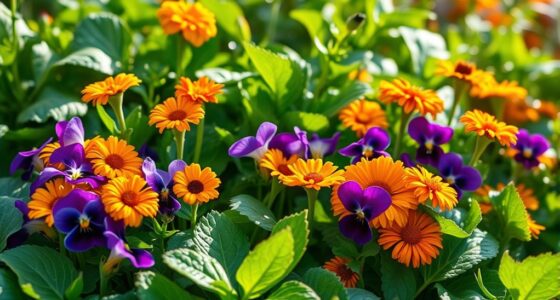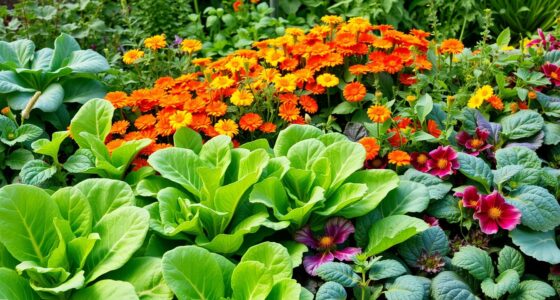Imagine the satisfaction of stepping onto your balcony or patio and being greeted by the vibrant colors and fresh aromas of homegrown vegetables and herbs. If you’re new to container gardening or exploring ways to enhance your gardening experience, understanding what to plant with tomatoes in a container can be the key to creating a thriving oasis right at your doorstep. Tomatoes, with their luscious fruit and appealing foliage, are a favorite amongst gardeners, even those who only have a small space to work with. By selecting the right companion plants for tomatoes in pots, you can maximize growth, flavor, and resilience in your garden. Let’s explore how you can make the most of your container gardening adventure!
Key Takeaways
- Companion planting boosts growth and flavor in tomatoes.
- Choose plants that thrive together in limited spaces.
- Container gardening is accessible for every beginner.
- Consider herbs, vegetables, and flowers as companions.
- Understanding plant relationships enhances garden health.
The Benefits of Companion Planting with Tomatoes
Engaging in companion planting with tomatoes can yield numerous advantages, enhancing your gardening experience. Plants positioned next to each other can promote healthier growth and flavor while fulfilling specific roles in pest management.
Enhancing Growth and Flavor
Utilizing the benefits of companion planting can significantly enhance growth and flavor in tomatoes. For example, basil is a well-known companion that not only improves the taste of tomatoes but also fosters a robust growing environment. The close proximity of these plants encourages better nutrient uptake and can lead to juicier, more flavorful produce.
Pest Repellent Qualities
Introducing pest repellent plants into your container garden creates a natural defense system for your tomatoes. Marigolds, for instance, are renowned for their ability to repel harmful pests like nematodes and aphids. By planting these alongside your tomatoes, you can minimize pest infestations, ensuring your plants remain healthy throughout the growing season.
Attracting Beneficial Insects
Incorporating diverse flowers and herbs can be instrumental in attracting beneficial insects, which play a vital role in maintaining a balanced ecosystem within your garden. Bees and ladybugs, for example, are essential for pollination and pest control. Plants such as borage and chives not only assist in deterring pests but also contribute to soil health, showing the multifaceted benefits of companion planting.

Ideal Container Sizes for Tomato Plants
Selecting the right container sizes is essential for healthy tomatoes and optimal growth. Understanding container dimensions for gardening can significantly impact how well your plants thrive. Ideally, a minimum of 5 gallons is recommended for most tomato varieties, providing enough space for extensive root systems. Taller containers are particularly effective as they support deeper roots, allowing for better nutrient absorption.
Choosing the Right Container Dimensions
When choosing container dimensions for gardening, consider the type of tomato you are planting. Indeterminate varieties, which grow taller and continue producing throughout the season, often require larger containers to accommodate their size. A container size of 7 to 10 gallons may be beneficial for these types, whereas determinate varieties can thrive in 5-gallon containers. Proper sizing helps ensure accessible resources for growth and fruit production.
Material Considerations for Containers
Materials for container planting play a pivotal role in the success of your tomato plants. Choose materials like plastic, ceramic, or treated wood, which balance moisture retention and drainage. Each material has its distinct advantages; for instance, ceramic retains heat well but may be heavier, while plastic is lightweight and often easier to handle. Consider the climate you’re gardening in, as it can affect how well different materials perform and how they influence the temperature of the soil.

Best Companion Herbs for Tomatoes
Choosing the right herbs to plant with tomatoes can significantly enhance both their growth and your culinary experience. The best companion herbs for tomatoes serve not just to complement their flavor in the kitchen but also to provide benefits in the garden. Two standout options include basil and oregano, both of which thrive alongside tomatoes in container gardening.
Basil: The Classic Pairing
Basil is often considered the quintessential herb to pair with tomatoes. This herb not only enriches the flavor of tomato dishes but also offers remarkable pest-repelling qualities. Its aromatic leaves keep destructive insects at bay, protecting your tomato plants and improving overall plant health.
Oregano: A Flavorful Companion
Oregano serves as another excellent choice among herbs to plant with tomatoes. This herb attracts beneficial pollinators, which can improve the overall health of your garden. Additionally, oregano features flowers that provide excellent habitats for these pollinators, making them a valuable asset in container gardening. Their growth requirements align well with those of tomatoes, and they both share a space beautifully.
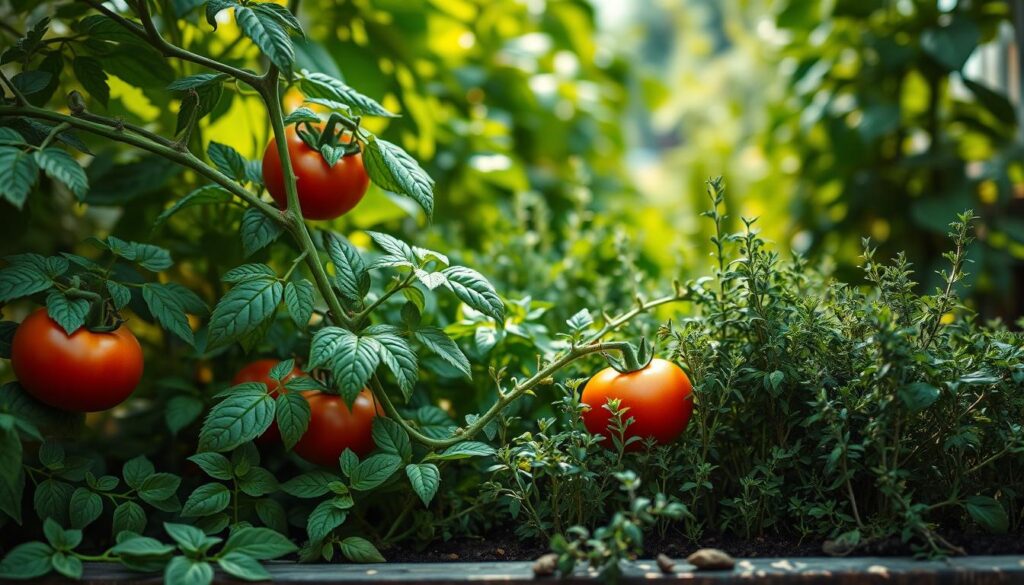
| Herb | Pest Repellent Qualities | Culinary Uses |
|---|---|---|
| Basil | Repels whiteflies, mosquitoes, and other pests | Perfect for sauces, salads, and pesto |
| Oregano | Attracts beneficial pollinators | Ideal for Italian, Greek, and Mediterranean dishes |
Integrating these container gardening herbs not only boosts your tomato plants but also enriches your culinary repertoire. With the proper care and attention, these herbs can flourish alongside your tomatoes, creating a thriving garden space.
Vegetables That Thrive Beside Tomatoes
In the world of container vegetable gardening, selecting the right combinations can lead to a bountiful harvest. Knowing which vegetables that grow well with tomatoes not only maximizes your space but enhances the overall health of your garden. Two excellent examples of tomato companion vegetables are peppers and carrots. Each of these vegetables enjoys a harmonious relationship with tomatoes, resulting in mutual benefits.
Peppers: A Spicy Combination
Peppers, belonging to the same nightshade family as tomatoes, share similar growing conditions and are a delightful addition to your container garden. When planting these two together, you can expect an appreciation of flavors in various dishes. The proximity can also promote healthy growth as both thrive in warm soil and enjoy plenty of sunlight.
Carrots: Rooting for Each Other
Carrots contribute an interesting dynamic to container gardening. By growing deeper in the soil, they help aerate the soil around tomato roots, allowing for better access to nutrients and water. This unique relationship between carrots and tomatoes enhances growth potential for both, yielding a more productive garden plot.
| Vegetable | Benefits of Pairing with Tomatoes | Planting Depth | Sunlight Needs |
|---|---|---|---|
| Peppers | Similar growing conditions, enhances flavor | 1-2 inches | Full sun |
| Carrots | Aerates soil, shares nutrients | 0.5-1 inch | Full sun |
Combining these tomato companion vegetables not only enriches your container garden, but it also enables healthier plants and increased yields throughout the growing season.
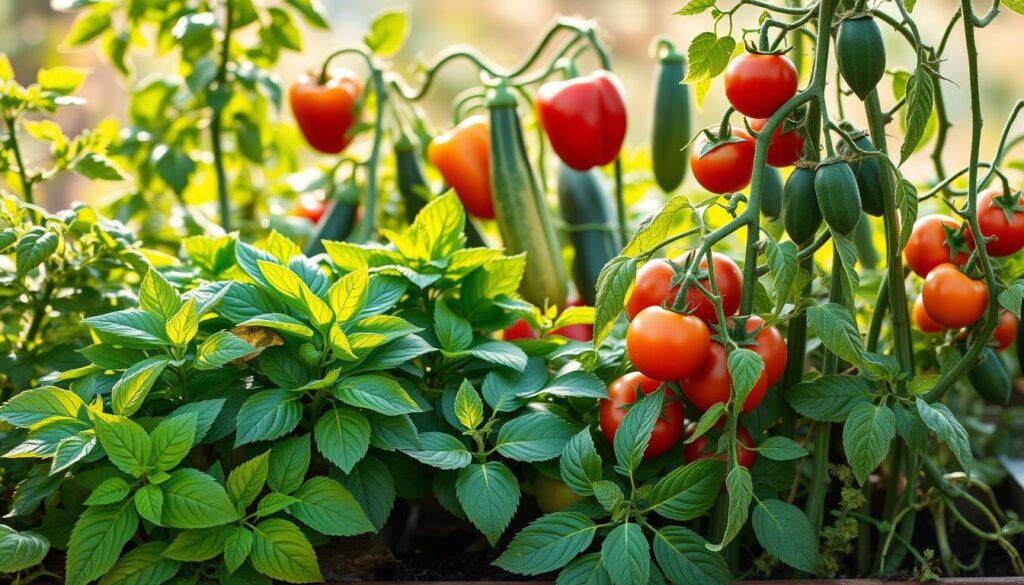
Flowers That Complement Tomato Plants
Including flowers in your container gardening enhances the visual appeal while providing benefits to your tomato plants. The best flowers for tomato plants not only create a vibrant display but also contribute to healthier growth and pest management. Consider adding these companion flowers to your garden for optimal results.
Marigolds: Nature’s Pest Control
Marigolds are renowned as one of the most effective pest control flowers. Their vibrant blooms not only attract beneficial insects but also help deter pests like aphids and nematodes. Growing marigolds close to your tomatoes can create a protective barrier, making it one of the best flowers for tomato plants. The bright flowers can enhance the aesthetic of your container garden, creating a lively atmosphere.
Nasturtiums: Attractive and Edible
Nasturtiums bring a unique blend of beauty and functionality to your container garden. These colorful flowers are not only visually striking but are also edible, making them a delightful addition to your salads. Nasturtiums effectively act as trap crops, luring aphids away from your tomatoes and minimizing disease risk. As companion flowers for container gardening, they attract pollinators and provide essential pest control benefits. Incorporating these flowers helps create a balanced ecosystem in your garden.

What Not to Plant with Tomatoes
Knowing which plants to avoid with tomatoes is essential for a thriving container garden. Certain species not only compete for resources but can also lead to severe companion planting conflicts.
Avoiding Planting Conflicts
When planning your tomato container garden, steer clear of nightshade family members, including peppers and eggplants. These plants share similar pests and diseases, causing more harm than good in close quarters. Heavy feeders, such as broccoli and cabbage, are also among the plants to avoid with tomatoes. They deplete vital nutrients from the soil, which can hinder your tomatoes’ growth and overall health.
Common Companion Planting Mistakes
Many gardeners overlook the importance of avoiding certain plants, leading to common gardening mistakes. Planting companions without understanding their needs often results in nutrient competition or pest issues. Always research plant compatibility to maximize your yields and enjoy a flourishing garden experience.

Soil Tips for Container Tomatoes
Growing tomatoes in containers requires attention to the type of soil used. The right soil significantly affects their growth and productivity. An ideal soil mix for gardening with tomatoes should have excellent drainage, be rich in nutrients, and maintain a proper pH level. With the right preparation, you can create a thriving environment for both your tomatoes and their companion plants.
Optimal Soil Mixtures for Growth
For successful container tomatoes, aim for a nutrient-rich soil that supports their growth needs. A well-balanced mix often includes:
- Quality potting soil
- Compost for enhanced nutrients
- Pearlite or vermiculite to improve drainage
This combination ensures a light, airy structure crucial for root development and water retention. Regularly testing your soil’s pH and nutrient levels can help maintain an ideal soil mix for gardening, fostering robust plants that produce plentiful fruit.
Nutrient Requirements for Container Plants
Tomatoes flourish in soil for container tomatoes that is not only rich in organic matter but also balanced in essential nutrients. Important nutrients to consider include:
| Nutrient | Function | Sources |
|---|---|---|
| Nitrogen | Supports leafy growth | Compost, fish emulsion |
| Phosphorus | Encourages root and flower development | Bone meal, rock phosphate |
| Potassium | Enhances fruit quality and disease resistance | Wood ash, greensand |
Incorporating these nutrients into your soil mix promotes healthy growth and yields delicious, juicy tomatoes. Monitoring and adjusting the nutrient levels throughout the growing season are key to maintaining that beneficial soil environment.

Watering Your Container Tomatoes and Companions
Getting the watering routine right is crucial for the success of your container tomatoes and their companions. Understanding the watering needs of these plants ensures they thrive without succumbing to overwatering or underwatering. Implementing effective watering tips for container tomatoes will lead to optimal growth and produce luscious fruit.
Understanding Watering Needs
Tending to container gardening watering requires being attentive to the moisture levels in your pots. Generally, tomatoes prefer their soil to be consistently moist yet not waterlogged. It’s beneficial to check your plants regularly, ensuring the soil remains damp but avoiding saturation. Weather conditions, container size, and plant maturity all influence how much water your tomatoes actually need.
Signs of Overwatering or Underwatering
Identifying the right balance in watering is essential for maintaining plant health. Watch for overwatering signs such as yellowing leaves, wilted plants, or mushy stems, which indicate your tomatoes may be suffering from excess moisture. On the flip side, underwatering manifests through dry soil and wilting leaves. Maintaining a close watch on your plants will help you adjust your watering technique as needed.
| Watering Condition | Signs | Solutions |
|---|---|---|
| Overwatering | Yellow leaves, mushiness, slow growth | Reduce watering, check drainage |
| Underwatering | Wilting, dry soil, stunted growth | Increase watering, establish a regular schedule |

Sunlight Requirements for Container Gardens
Understanding the sunlight needs for tomatoes is crucial for successful gardening in sunlight. These vibrant plants thrive when they receive adequate sunlight, which directly impacts their growth and fruit production. Designing your container garden with proper light conditions can make a significant difference in the health of your tomatoes and their companions.
Ideal Light Conditions for Tomatoes
Tomatoes flourish in full sun, which means they require at least 6 to 8 hours of direct sunlight each day. Positioning your containers in a spot that maximizes exposure to direct sunlight is essential. Factors such as surrounding trees or buildings can cast shadows on your plants, limiting their access to the necessary light. To ensure optimal growth, regularly assess your container garden light conditions throughout the day.
Positioning Your Containers for Success
Choosing the right location for your tomato containers can enhance their growth efficiency. When arranging your garden, keep in mind the orientation of the sun. Placing containers in an area that faces south or west generally provides the best light exposure. Be mindful of how neighboring structures or tall plants may affect the light reaching your tomatoes.
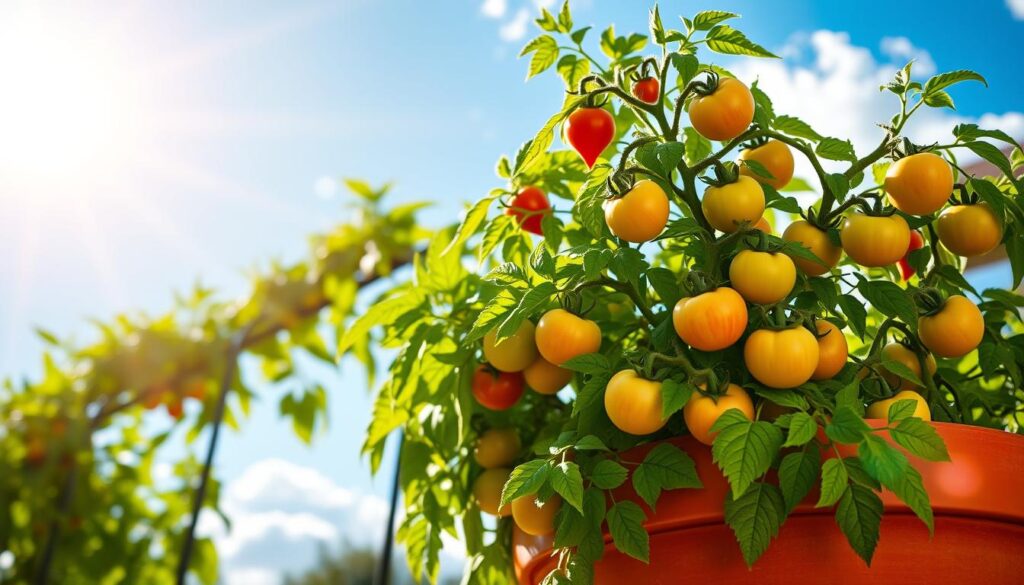
| Container Position | Sunlight Exposure | Effect on Tomatoes |
|---|---|---|
| South-facing | Full sun (8+ hours) | Optimal growth and fruit yield |
| West-facing | Afternoon sun (6-8 hours) | Good fruit development, may require additional watering |
| East-facing | Morning sun (4-6 hours) | Decent growth, shorter sunlight duration |
| North-facing | Limited sunlight ( | Poor growth and fruiting potential |
By diligently assessing your space and aligning your container garden with the right sunlight needs for tomatoes, you can create an engaging and productive environment for your plants.
Fertilizing Tips for Companion Plants
Fertilizing companion plants is essential for promoting healthy growth and maximizing yields, especially in container gardening where soil nutrients can deplete quickly. You should focus on selecting the right fertilizers that align with the needs of your specific plants, particularly when you’re working with organic fertilizers for tomatoes. Understanding when and how to fertilize can make a significant difference in the success of your garden.
When and How to Fertilize
Timing is crucial when it comes to fertilizing your plants. Begin by fertilizing your soil before planting; this helps set a solid foundation for growth. During the growing season, consider feeding your plants every 4-6 weeks, depending on their nutrient needs. Monitoring the foliage can also provide clues. If plants appear yellow or show stunted growth, it may be time to apply more fertilizer. Utilize organic options like compost, seaweed extract, or fish emulsion to nurture your soil and plants while maintaining an eco-friendly approach.
Organic vs. Chemical Fertilizers
When evaluating fertilizer options, it’s important to weigh the benefits of organic fertilizers for tomatoes against chemical alternatives. Organic fertilizers improve soil health over time, encouraging beneficial microorganisms. They tend to release nutrients more slowly, reducing the risk of over-fertilization. While chemical fertilizers may offer a quick nutrient boost, they can lead to soil degradation long-term. As you explore fertilizer tips for container gardening, prioritize sustainability for vibrant and healthy plants.
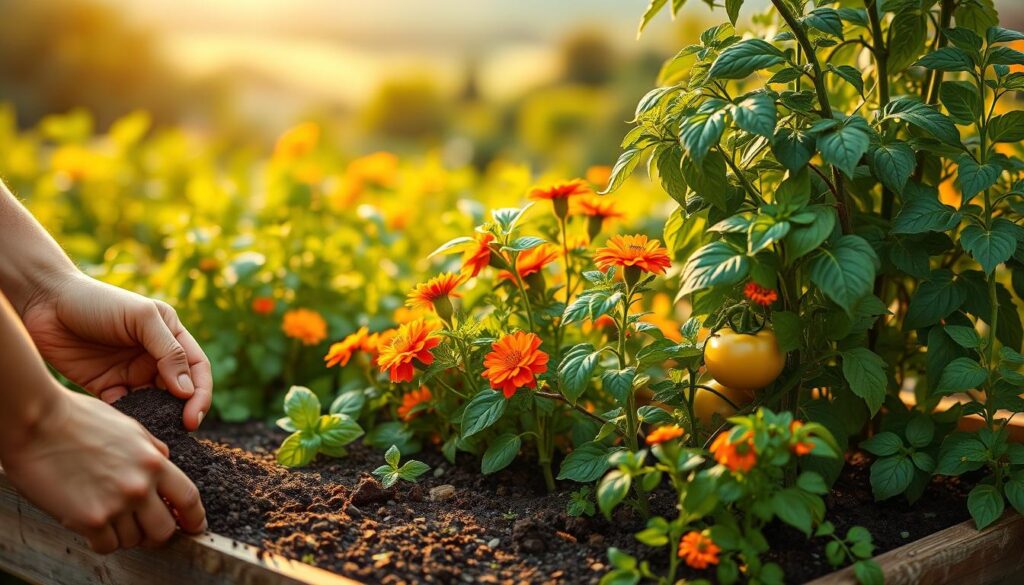
Seasonal Considerations for Companion Planting
Understanding seasonal planting tips is essential for maximizing your container gardening success. The growing seasons for tomatoes and their companions can vary significantly with climate and weather patterns. Adapting your strategy for planting and care according to these changes ensures that all your plants thrive. By mastering the art of gardening by season, you can enhance not only growth but also yields in your container garden.
Planning Planting Around Seasons
Timing is everything when it comes to planting your container garden. Begin by identifying the best seasons for each plant type you wish to grow. Tomatoes generally do well in warmer months, while other companion plants might prefer slightly different conditions. Researching the optimal planting times can help you create a diverse and fruitful garden.
Adjusting with Changing Weather
Weather fluctuations can affect plant health, making adjusting container gardening practices crucial. Stay attentive to temperature changes, moisture levels, and sunlight availability. This observation will help you modify watering schedules and care routines. Regularly check the environment and make necessary adjustments to ensure your tomatoes and their companions flourish despite the elements.
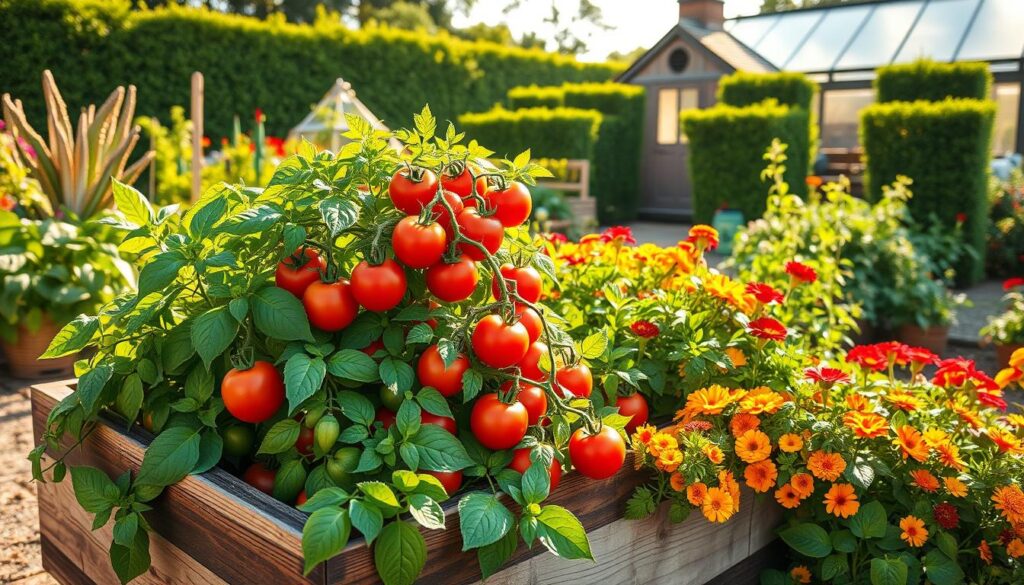
Monitoring for Pests and Diseases
Keeping your container tomatoes healthy requires vigilance against common pests and diseases. As you nurture your plants, it’s vital to recognize the signs of issues that may arise. Effective pest management for container tomatoes starts with understanding what to look for. Early identification can save your crop and enhance your gardening experience.
Common Pests Affecting Tomatoes
Tomato plants can face threats from various pests. Notable pests include:
- Aphids: Small sap-sucking insects that can weaken plants.
- Hornworms: Large green caterpillars that can defoliate your plants rapidly.
- Whiteflies: These tiny flying pests also suck sap and can spread diseases.
Recognizing these pests early allows you to take action before they cause significant damage. Implementing gardening pest prevention methods, such as using neem oil or introducing natural predators, can mitigate these common threats.
Prevention Strategies for Container Plants
To maintain a thriving container garden, you must adopt several proactive strategies:
- Regularly inspect your plants for any signs of infestation or disease.
- Promote diversity in your garden by including pest-repelling companions alongside your tomatoes.
- Practice crop rotation to reduce soil-borne diseases and pests.
- Implement organic solutions like insecticidal soap to manage pests without harming beneficial insects.
Being aware of tomato diseases such as blight and practicing preventative measures can enhance your gardening success. Monitoring, along with these strategies, positions you to enjoy a bountiful harvest.
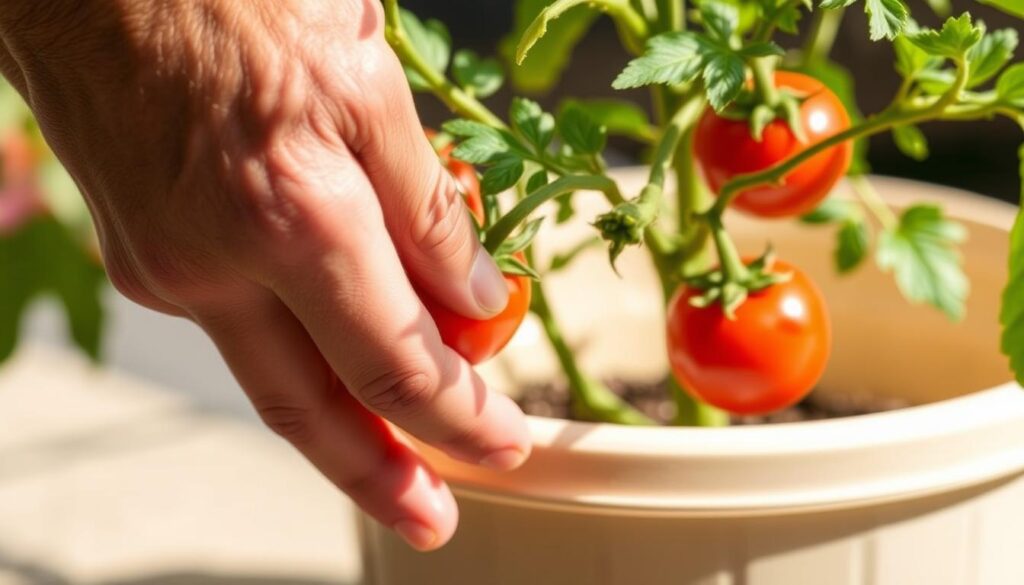
Harvesting Tips for Tomatoes and Companions
Achieving the satisfaction of harvesting tomatoes requires attention to detail. Knowing when to harvest plays a crucial role in maximizing flavor and ensuring the best quality in your homegrown produce. Each type of tomato may have slight variations in ripening, but observing key indicators can guide your timing.
Knowing When to Harvest
The best time to harvest tomatoes is when they reach full ripeness. Look for vibrant coloration and a firm texture. If you detect a slight give when applying gentle pressure, the tomatoes are likely ready to pick. Staying vigilant about signals from your garden can lead to flavorful results.
Storing Your Fresh Produce
After harvesting, proper handling of your tomatoes is essential to maintain freshness. Follow these produce storage tips:
- Store in a cool, dark place to avoid spoilage.
- Avoid refrigeration, as this can diminish flavor and texture.
- Use companion herbs to enhance the dishes made with your tomatoes.

Expanding Your Container Garden: Other Plants to Consider
When expanding your container garden, you open the door to a variety of new and exciting plant options. Including other plants for container planting not only enhances the yield but also promotes a healthier growing environment. Two excellent choices for your garden are broccoli and spinach.

Broccoli: A Surprising Container Option
Broccoli thrives in larger containers, making it a viable option for container gardening. This nutrient-rich vegetable requires sufficient space for its roots, but with proper care, you can expect a robust harvest. Broccoli benefits from the companion planting of certain herbs, which can help deter pests, making it a worthwhile addition to your expanding container garden.
Spinach: Fast-Growing Greens
Spinach stands out as one of the fastest-growing container vegetables, allowing for multiple plantings in a single season. This leafy green is perfect for smaller containers and can yield a continuous supply of fresh produce if you opt for succession planting. Including spinach in your garden not only provides you with nutritious greens but also complements the growth cycle of your other plants.
By incorporating diverse plants into your container garden, you enjoy greater resilience against pests and diseases, as well as improved nutrient exchange in the soil. The combination of broccoli and spinach offers a compelling example of how expanding your gardening efforts can lead to a thriving and productive space.
Community and Resources for Container Gardening
Engaging with your local gardening community and utilizing available resources can significantly enrich your container gardening experience. Connecting with fellow gardeners provides a platform for sharing knowledge and insights. You will find an array of gardening resources that cater to varying skill levels and interests. Whether you are looking for hands-on assistance or simply seeking to expand your understanding, these collaborative spaces offer endless possibilities.
Local Gardening Groups and Clubs
Joining local gardening groups and clubs presents a fantastic opportunity to immerse yourself in community gardening. These organizations often hold workshops and events where you can learn directly from experienced gardeners. Sharing tips on companion planting and container care can enhance your gardening skills and bring fresh ideas to your practices. You might find that local gardeners are more than willing to share their personal success stories, giving you practical insights into what works.
Online Communities for Advice
Online gardening forums have become a treasure trove of information and support. In these digital spaces, you can ask questions, share your experiences, and discover solutions to common challenges. These forums are perfect for accessing a wide range of gardening resources. From discussion threads focusing on specific issues to general advice on container gardening techniques, the wealth of knowledge available is truly remarkable. You will likely connect with passionate gardeners who share your enthusiasm and can help you troubleshoot any concerns that arise.
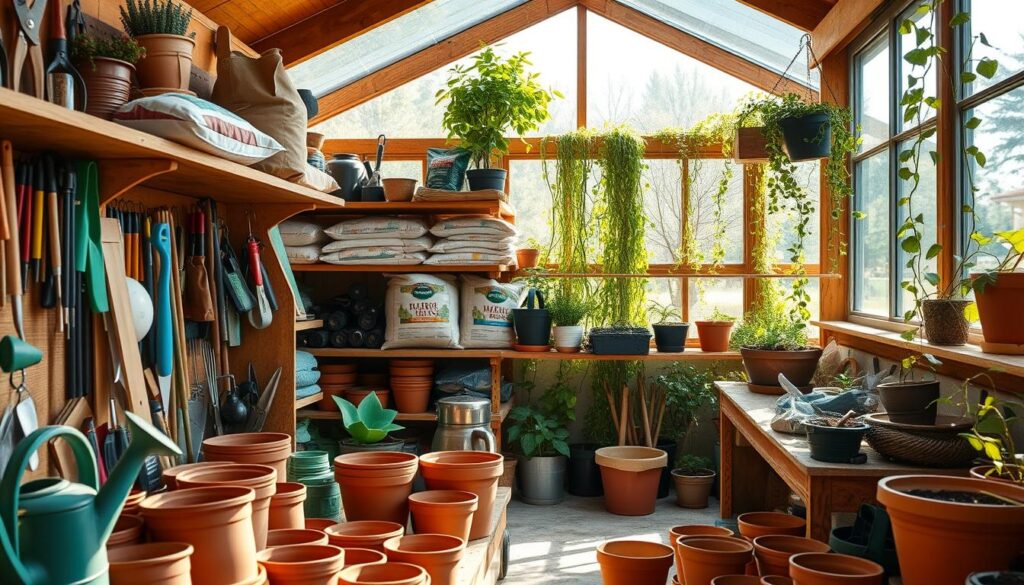
Conclusion: A Thriving Container Garden
As you wrap up your journey into the world of container gardening, it’s essential to reflect on the benefits of companion planting. By carefully selecting plants that thrive together, you not only maximize the productivity of your space but also create a sustainable ecosystem. This approach leads to healthier plants, improved growth, and even more flavorful produce right from your container garden.
Recap of Companion Planting Benefits
The advantages of companion planting are vast, as it helps deter pests, encourages beneficial insects, and can enhance the overall flavor profile of your harvest. This synergy amongst plants allows for a thriving container garden that blossoms with life and flavor. Implementing successful gardening tips, such as knowing which plants work well together, can greatly enhance your gardening experience.
Encouragement for Your Gardening Journey
Remember, gardening is a continuous learning process. Each planting season offers new opportunities to experiment and refine your approach. Keep nurturing your curiosity and adapting your methods as needed. With time and patience, you’ll enjoy the fruits of your labor, making your container gardening journey both rewarding and delicious.



